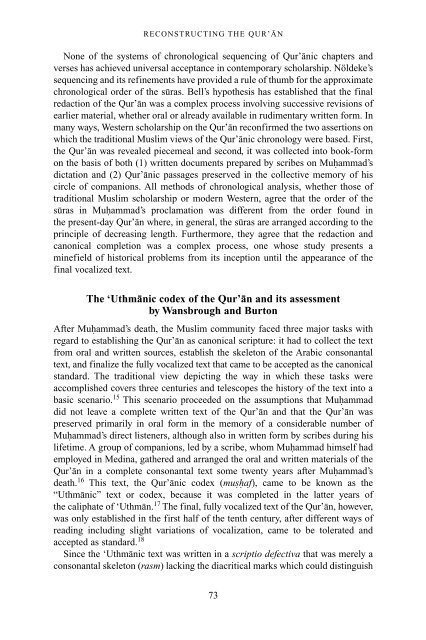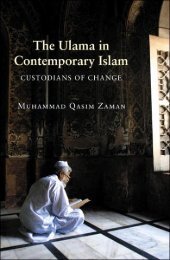The Qur'an in its historical context (pdf - Islam and Christian-Muslim ...
The Qur'an in its historical context (pdf - Islam and Christian-Muslim ...
The Qur'an in its historical context (pdf - Islam and Christian-Muslim ...
Create successful ePaper yourself
Turn your PDF publications into a flip-book with our unique Google optimized e-Paper software.
RECONSTRUCTING THE QUR’AN<br />
None of the systems of chronological sequenc<strong>in</strong>g of Qur’anic chapters <strong>and</strong><br />
verses has achieved universal acceptance <strong>in</strong> contemporary scholarship. Nöldeke’s<br />
sequenc<strong>in</strong>g <strong>and</strong> <strong>its</strong> ref<strong>in</strong>ements have provided a rule of thumb for the approximate<br />
chronological order of the suras. Bell’s hypothesis has established that the f<strong>in</strong>al<br />
redaction of the Qur’an was a complex process <strong>in</strong>volv<strong>in</strong>g successive revisions of<br />
earlier material, whether oral or already available <strong>in</strong> rudimentary written form. In<br />
many ways, Western scholarship on the Qur’an reconfirmed the two assertions on<br />
which the traditional <strong>Muslim</strong> views of the Qur’anic chronology were based. First,<br />
the Qur’an was revealed piecemeal <strong>and</strong> second, it was collected <strong>in</strong>to book-form<br />
on the basis of both (1) written documents prepared by scribes on Muhammad’s<br />
dictation <strong>and</strong> (2) Qur’anic passages preserved <strong>in</strong> the collective memory of his<br />
circle of companions. All methods of chronological analysis, whether those of<br />
traditional <strong>Muslim</strong> scholarship or modern Western, agree that the order of the<br />
suras <strong>in</strong> Muhammad’s proclamation was different from the order found <strong>in</strong><br />
the present-day Qur’an where, <strong>in</strong> general, the suras are arranged accord<strong>in</strong>g to the<br />
pr<strong>in</strong>ciple of decreas<strong>in</strong>g length. Furthermore, they agree that the redaction <strong>and</strong><br />
canonical completion was a complex process, one whose study presents a<br />
m<strong>in</strong>efield of <strong>historical</strong> problems from <strong>its</strong> <strong>in</strong>ception until the appearance of the<br />
f<strong>in</strong>al vocalized text.<br />
<strong>The</strong> ‘Uthmanic codex of the Qur’an <strong>and</strong> <strong>its</strong> assessment<br />
by Wansbrough <strong>and</strong> Burton<br />
After Muhammad’s death, the <strong>Muslim</strong> community faced three major tasks with<br />
regard to establish<strong>in</strong>g the Qur’an as canonical scripture: it had to collect the text<br />
from oral <strong>and</strong> written sources, establish the skeleton of the Arabic consonantal<br />
text, <strong>and</strong> f<strong>in</strong>alize the fully vocalized text that came to be accepted as the canonical<br />
st<strong>and</strong>ard. <strong>The</strong> traditional view depict<strong>in</strong>g the way <strong>in</strong> which these tasks were<br />
accomplished covers three centuries <strong>and</strong> telescopes the history of the text <strong>in</strong>to a<br />
basic scenario. 15 This scenario proceeded on the assumptions that Muhammad<br />
did not leave a complete written text of the Qur’an <strong>and</strong> that the Qur’an was<br />
preserved primarily <strong>in</strong> oral form <strong>in</strong> the memory of a considerable number of<br />
Muhammad’s direct listeners, although also <strong>in</strong> written form by scribes dur<strong>in</strong>g his<br />
lifetime. A group of companions, led by a scribe, whom Muhammad himself had<br />
employed <strong>in</strong> Med<strong>in</strong>a, gathered <strong>and</strong> arranged the oral <strong>and</strong> written materials of the<br />
Qur’an <strong>in</strong> a complete consonantal text some twenty years after Muhammad’s<br />
death. 16 This text, the Qur’anic codex (mushaf), came to be known as the<br />
“Uthmanic” text or codex, because it was completed <strong>in</strong> the latter years of<br />
the caliphate of ‘Uthman. 17 <strong>The</strong> f<strong>in</strong>al, fully vocalized text of the Qur’an, however,<br />
was only established <strong>in</strong> the first half of the tenth century, after different ways of<br />
read<strong>in</strong>g <strong>in</strong>clud<strong>in</strong>g slight variations of vocalization, came to be tolerated <strong>and</strong><br />
accepted as st<strong>and</strong>ard. 18<br />
S<strong>in</strong>ce the ‘Uthmanic text was written <strong>in</strong> a scriptio defectiva that was merely a<br />
consonantal skeleton (rasm) lack<strong>in</strong>g the diacritical marks which could dist<strong>in</strong>guish<br />
73



